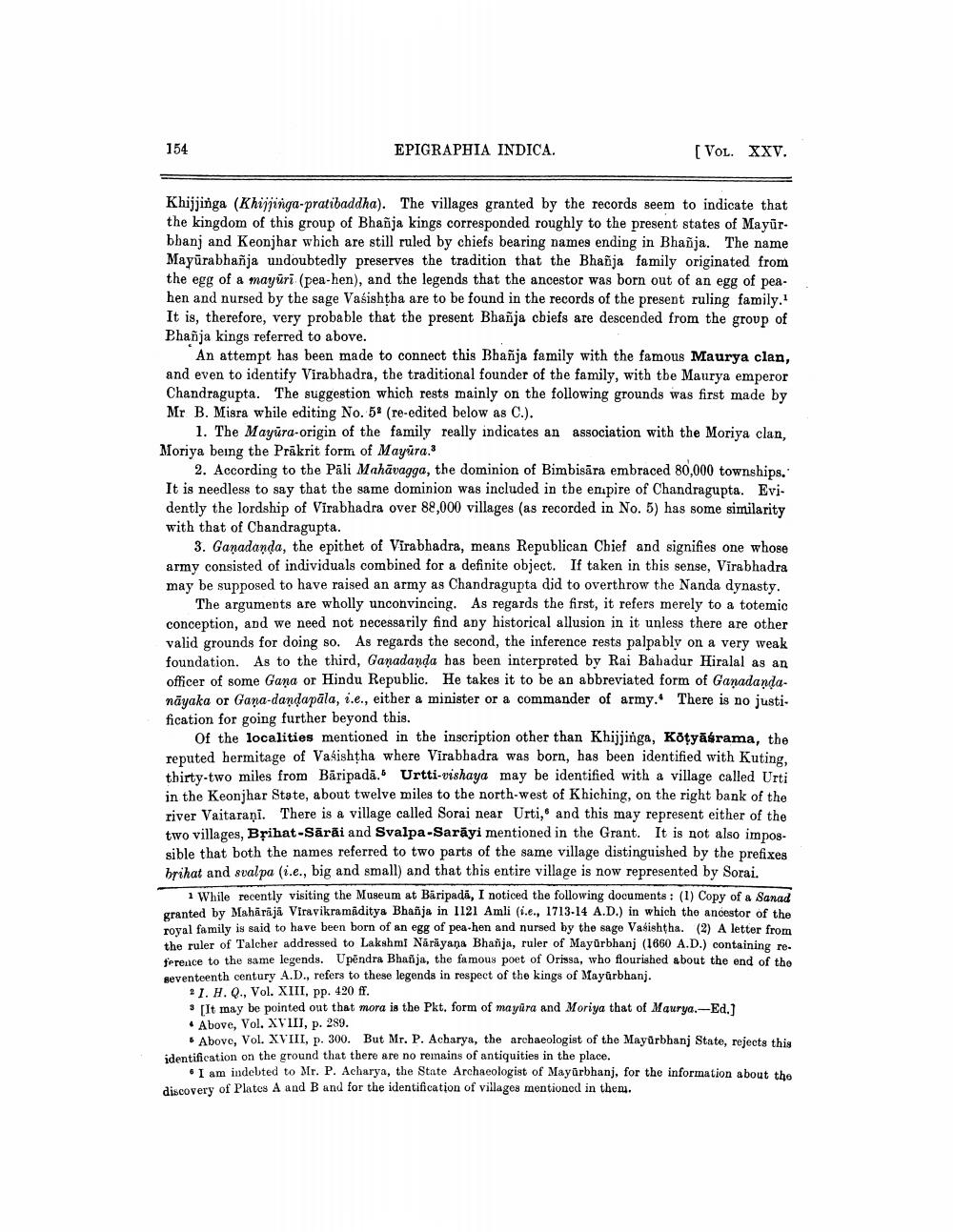________________
154
EPIGRAPHIA INDICA.
[VOL. xxv.
Khijjinga (Khijjinga-pratibaddha). The villages granted by the records seem to indicate that the kingdom of this group of Bhañja kings corresponded roughly to the present states of Mayür. bbanj and Keonjhar which are still ruled by chiefs bearing names ending in Bhanja. The name Mayūrabhañja undoubtedly preserves the tradition that the Bhañja family originated from the egg of a mayuri (pea-hen), and the legends that the ancestor was born out of an egg of peahen and nursed by the sage Vašishtha are to be found in the records of the present ruling family.! It is, therefore, very probable that the present Bhanja chiefs are descended from the group of Phañja kings referred to above.
An attempt has been made to connect this Bbañja family with the famous Maurya clan, and even to identify Virabhadra, the traditional founder of the family, with the Maurya emperor Chandragupta. The suggestion which rests mainly on the following grounds was first made by Mr B. Misra while editing No. 5° (re-edited below as C.).
1. The Mayura-origin of the family really indicates an association with the Moriya clan, Moriya being the Präkrit form of Mayura.
2. According to the Pali Mahāvagga, the dominion of Bimbisära embraced 80,000 townships. It is needless to say that the same dominion was included in the empire of Chandragupta. Evidently the lordship of Virabhadra over 88,000 villages (as recorded in No. 5) has some similarity with that of Chandragupta.
3. Ganadanda, the epithet of Virabhadra, means Republican Chief and signifies one whose army consisted of individuals combined for a definite object. If taken in this sense, Virabhadra may be supposed to have raised an army as Chandragupta did to overthrow the Nanda dynasty.
The arguments are wholly unconvincing. As regards the first, it refers merely to a totemic conception, and we need not necessarily find any historical allusion in it unless there are other valid grounds for doing so. As regards the second, the inference resta palpably on a very weak foundation. As to the third, Ganadanda has been interpreted by Rai Bahadur Hiralal as an officer of some Gana or Hindu Republic. He takes it to be an abbreviated form of Ganadandanāyaka or Gana-dandapāla, i.e., either a minister or a commander of army. There is no justi. fication for going further beyond this.
Of the localities mentioned in the inscription other than Khijjinga, Köțyāśrama, the reputed hermitage of Vasishtha where Virabhadra was born, has been identified with Kuting, thirty-two miles from Bäripadā. Urtti-vishaya may be identified with a village called Urti in the Keonjhar State, about twelve miles to the north-west of Khiching, on the right bank of the river Vaitarani. There is a village called Sorai near Urti, and this may represent either of the two villages, Bșihat-Sārāi and Svalpa-Sarayi mentioned in the Grant. It is not also impossible that both the names referred to two parts of the same village distinguished by the prefixes brihat and svalpa (i.e., big and small) and that this entire village is now represented by Sorai.
1 While recently visiting the Museum at Baripada, I noticed the following documents: (1) Copy of a Sanad granted by Maharija Viravikramaditya Bhanja in 1121 Amli (i.e., 1713-14 A.D.) in which the ancestor of the royal family is said to have been born of an egg of pea-hen and nursed by the sage Valishtha. (2) A letter from the ruler of Talcher addressed to Lakshmi Narayana Bhanja, ruler of Mayurbhanj (1660 A.D.) containing reference to the same legends. Upendra Bhaja, the famous poet of Orissa, who flourished about the end of the seventeenth century A.D., refers to these legends in respect of the kings of Mayurbhanj. : 1. H.Q., Vol. XIII, pp. 420 ff.
It may be pointed out that mora is the Pkt, form of mayira and Moriya that of Maurya.-Ed.1 . Above, Vol. XVIII, p. 289.
Above, Vol. XVIII, p. 300. But Mr. P. Acharya, the archaeologist of the Mayurbhanj State, rejects this identification on the ground that there are no remains of antiquities in the place.
I am indebted to Mr. P. Acharya, the State Archaeologist of Mayarbhanj, for the information about the discovery of Platos A and B and for the identification of villages mentioned in them.




